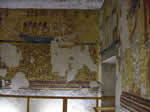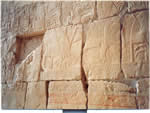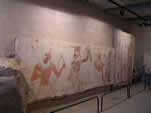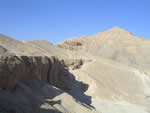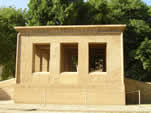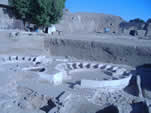Valley of Kings
It was recently announced that another tomb was discovered in the Valley of the Kings. Number KV63 was discovered by Dr Otto Schaden. Previously, the last tomb was discovered by Howard Carter and Lord Carnarvon, KV62, the tomb of Tutankhamen. It varies, but generally there are over 12 tombs in the valley that can be visited. It is best to check on the day you visit as you can be pleasantly surprised. Also, who knows who you might see, for example: Zahi Hawass, Sabri Azeb, and Mustapha Waseri.
Tomb of Ay
This is a separate ticket and is located in the Western Valley of the Valley of the Kings. This site is often completely deserted by tourists as it is over 2km from the ticket office. The right driver will take you up the winding path where desert foxes roam. Did Ay murder Tutankhamen; the jury is still out on that.
Carter House
Just outside the Valley is the house that Carter lived in whilst excavating Tutankhamen’s tomb, which was recently restored and is open to the public. It was built for him by Lord Carnarvon. There is a short viewing of Carter’s ghost talking about his work. It is open to the public and no ticket is required.
Valley of Queens
Although the tomb of Nefertari is closed, except to special groups with a lot of money, it does not mean there is nothing to see here. There are the tombs of two princes and a queen open and from here you can walk to the workman’s village past the shrine of Meretsegner and Ptah.
Temple of Hatshepsut at Deir El Bahri
An iconic temple of a queen (or rather king, as there was no title for a female ruler so Hatshepsut was always called the Ancient Egyptian equivalent of king). The architecture of this temple, possibly inspired from its next door neighbour, is unique amongst mortuary temples. This is a very popular site with its own ticket office.
Assasif Tombs & Tomb of Pabasa
These two sites are surprising. The tickets are bought at the Hatshepsut ticket office, which is one of the busiest sites in Egypt, however almost nobody comes to these three tombs. Certainly not the big tour groups. Chat with the guards and have a cup of tea. The tombs are huge and there is a lot of excavation going on in the area, e.g. the tomb of Harwa (under the direction of Francesco Tiradritti).
Colossus of Memnon
Although almost everyone just looks at the big statues, take the time to wander along the road and see the excavations going on behind. Dr Hourig Sourouzian is excavating there and you have probably read about all the statuary she has found.
Mortuary Temple of Merenptah with museum
From the road it looks like there is nothing to see at this temple, but this is one of Luxor’s secrets with its museum and underground store rooms which have many pieces from the temple of Amenhotep III. Poor old Merenptah was the 13th son of Ramses II and must have given up expecting to succeed him. There was a need to build a temple quickly and he used many blocks from the temple of Amenhotep III which is behind the colossus of Memnon. The colour on these pieces is spectacular and I thoroughly recommend a visit to this site. The museum is open at a slightly later time around 8/9 am, although the temple opens at 6am.
Mortuary Temple of Seti I
One of my favourite sites in Egypt and one I love to take children to and re-enact scenes from the temple walls. The modesty of Seti is demonstrated clearly as the part of the temple dedicated to him is tiny and almost hidden. Totally unlike his more famous son Ramses II.
Mortuary Temple of Ramses II (Ramasseum)
This was the big destination of many a traveller doing the grand tour and they left their graffiti here, including Belzoni. The poem Ozymandes is connected with this site and I like to stand viewing the giant statue and recite it. The fallen statue is massive, carved from Aswan granite and a testimony to Ramses II ego.
Mortuary Temple of Ramses III (Medinet Habu)
On the right hand side on the outside wall, you can see the only depiction of a sea battle in Egyptian art. Also on the right is the temple of Tuthmosis III. I recommend this temple for colour. The temples were not dull sandstone when built, but vibrant, gaudy and completely over the top. This temple gives you a glimpse of that.
Workman’s Village at Deir el Medina Tomb of Pashedu
The ticket for the village entitles you to visit two tombs, the village and the small temple so are a great value. Get an additional ticket for Pashedu, which is up the hill. It is fascinating to see the place where the elite that built the valley of the kings lived, worked, and were buried. There is also an excellent book stall here. You can walk or take a donkey from the village, over the ridge to the temple of Hatshepsut. I call this path the poor man’s hot air balloon.
Nobles Tombs
- Roy and Shu Roy
- Khokha tombs Neferronpet, Dhutmosis and Nefersekheru
- Ramose, Khaemhet, Userhet
- Benji, Userhet, Khonsu
- Sennefer and Rekhmire
- Meena and Nakht
There are several sets of noble’s tombs. I love them all. These sites are infrequently visited and are much more interesting to the layman or children. My favourite is Rekhmire, which is a bit of a climb up the hill, there is so much detail of every aspect of Ancient Egyptian life. My second favourite is Roy. The colour is stunning and it overlooks Karnak temple. Location, location, location. The Beautiful Feast of the Valley would have gone straight past his door. The carvings in the entire Ramose group are wonderful and in the tomb of Ramose himself you can see the change of religion to Akhenaton and the Aton. There is also a lot of excavation going on in this area and sometimes the archaeologists are prepared to have a chat and tell you about their work.
Karnak Temple and the Open Air Museum
Everyone goes to Karnak temple but no group goes to the Open Air Museum. Inside there is the Middle Kingdom White Chapel of Senusret, which is exquisite. As for the rest of the temple, the botanical room shows Tuthmosis III as a rival to Napoleon with his love of science. The temple of Ptah where the guardians do a little trick with a mirror and the Sekhmet statue, the priests houses at the back of the sacred lake, Sphinx Avenue, and the excavations taking place in front of the first pylon are all worthwhile viewing. Take at least 10 days going round this temple, well maybe not quite that much, but you could.
Luxor Temple and the Mosque
Like Karnak temple, Luxor temple also has its less visited area. The mosque built inside the ancient temple has recently been restored and Mansour Boraik has published a great paper on the decoration and it is all now on display. Luxor temple now also has a block yard that is open for viewing which is well laid out by Chicago House. This temple is open in the evening so is great for a floodlight experience.






